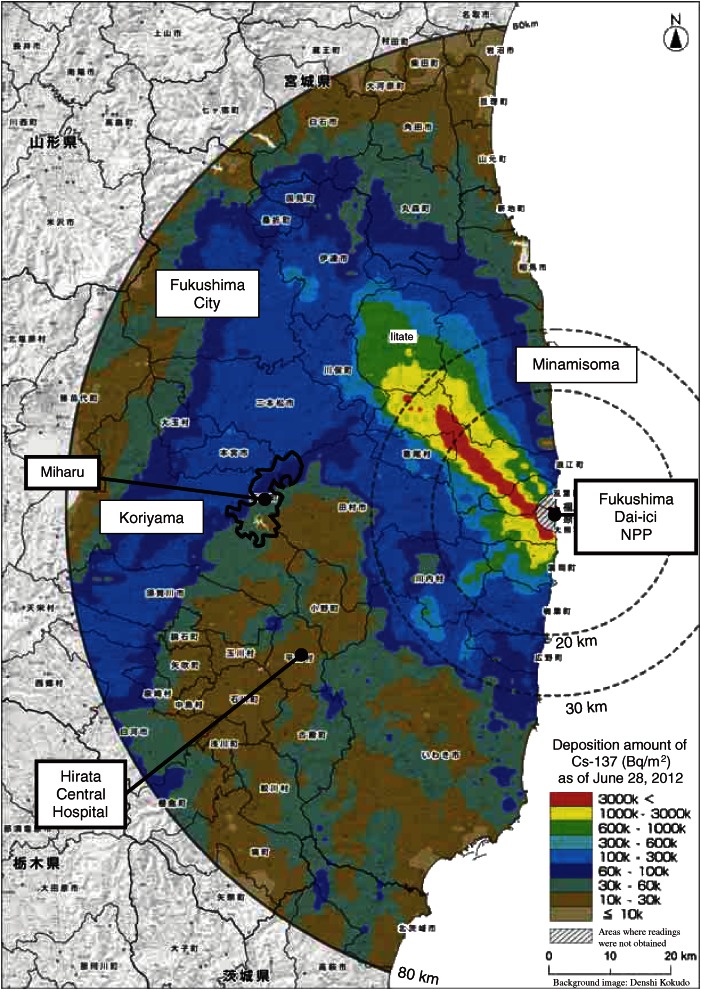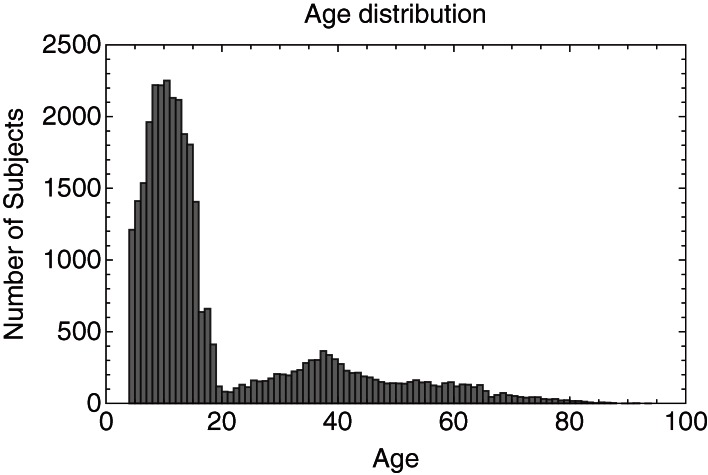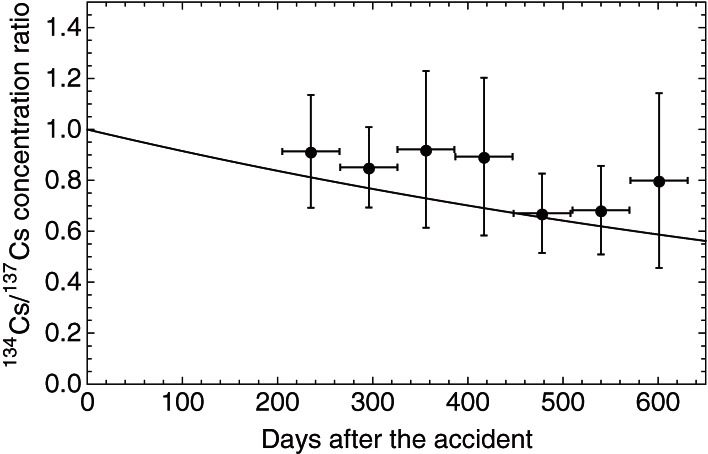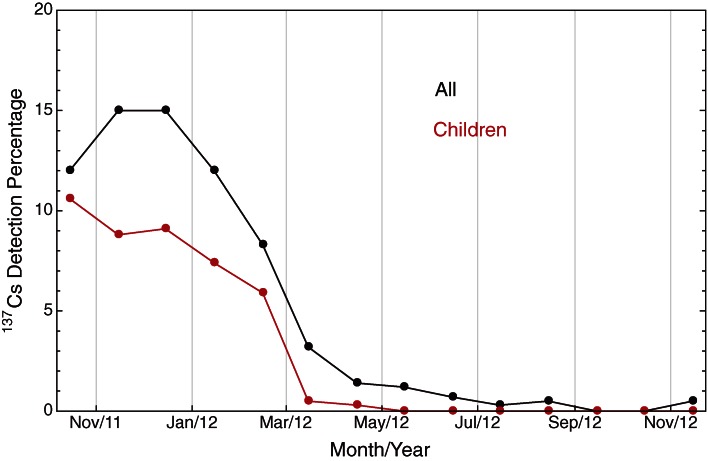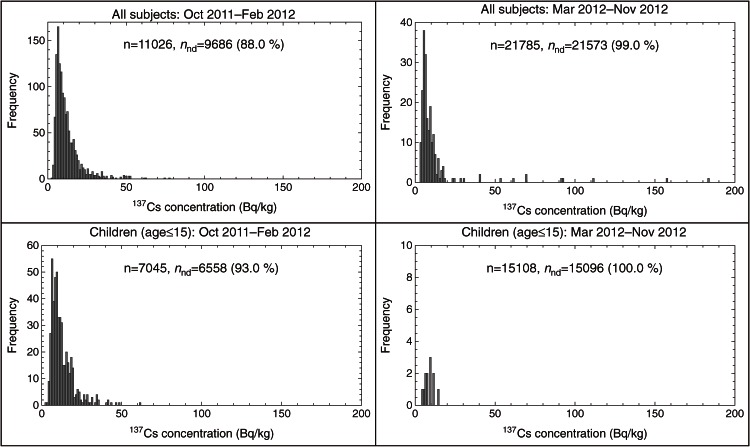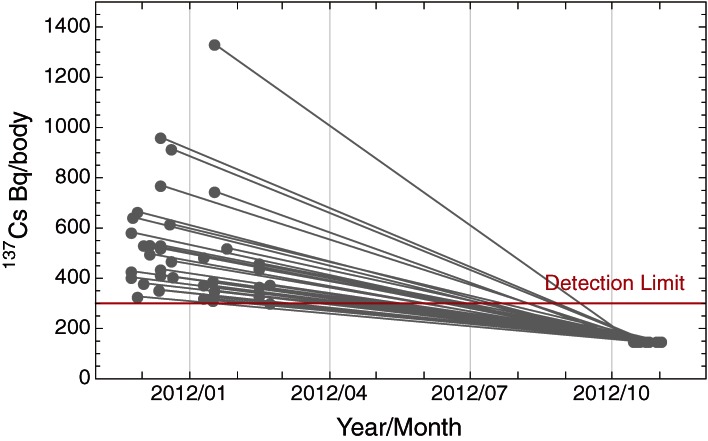Abstract
The Fukushima Dai-ichi NPP accident contaminated the soil of densely-populated regions in Fukushima Prefecture with radioactive cesium, which poses significant risks of internal and external exposure to the residents. If we apply the knowledge of post-Chernobyl accident studies, internal exposures in excess of a few mSv/y would be expected to be frequent in Fukushima.
Extensive whole-body-counter surveys (n = 32,811) carried out at the Hirata Central Hospital between October, 2011 and November, 2012, however show that the internal exposure levels of residents are much lower than estimated. In particular, the first sampling-bias-free assessment of the internal exposure of children in the town of Miharu, Fukushima, shows that the 137Cs body burdens of all children (n = 1,383, ages 6–15, covering 95% of children enrolled in town-operated schools) were below the detection limit of 300 Bq/body in the fall of 2012. These results are not conclusive for the prefecture as a whole, but are consistent with results obtained from other municipalities in the prefecture, and with prefectural data.
Keywords: Fukushima Dai-ichi NPP accident, radioactive cesium, whole-body counting, committed effective dose
1. Introduction
The severe accident involving the Fukushima Dai-ichi nuclear power plant (NPP),1) triggered by the Great East Japan Earthquake and resulting Tsunami on March 11, 2011, dispersed large amounts of radionuclides, which were deposited on soil and water in Fukushima Prefecture and surrounding regions of Japan. A recent airborne monitoring survey2) carried out by the Japanese government (Fig. 1) shows that the surface deposition density of 137Cs amounts to 60 k–300 kBq/m2 in such densely populated cities as Fukushima (population ≈280,000) and Koriyama (population ≈330,000).
Figure 1.
Deposition amount of 137Cs on the ground surface within a 80 km radius of the Fukushima Dai-ichi NPP (fifth airborne monitoring survey, as of June 28, 2012).2)
Post-Chernobyl accident studies show that the level of internal radiation exposure of residents from ingestion of contaminated foodstuffs is nearly proportional to the deposition density; according to the UNSCEAR 1988 report on the exposures from the Chernobyl accident,3) the mean transfer factor from 137Cs deposition density (kBq/m2) to first-year committed effective dose (µSv/y) for adults is about 20. If this also applies to the Fukushima Dai-ichi case, the committed effective dose (CED) would be about 2 mSv (i.e., average daily intake of 137Cs ≈400 Bq/day, or body burden of ≈60,000 Bq/body, or body concentration of ≈800–900 Bq/kg) for adults living in the region where the 137Cs deposition density is ∼100 kBq/m2 (typical of Fukushima City).
Note that the airborne monitoring surveys4) and the soil sample analyses5) have shown that the ratios of deposition amounts of 134Cs (half life T1/2=2.1 y) against those of 137Cs (T1/2=30 y) in soil samples, extrapolated back to March 2011, were about 1 : 1, so that the actual CED due to radioactive cesium in Fukushima would be higher by a factor of ∼2.5 than the 2 mSv estimate from 137Cs alone.
There are already several indications that the actual CEDs of Fukushima residents are much lower than estimated above, one being the whole-body counting conducted by the Fukushima prefectural government, starting in late June 2011.
So far, >100,000 residents have been screened with whole-body counters (WBC), and >99.9% of them showed a CED of less than 1 mSv (the sum of the contributions from 134Cs and 137Cs together),6) as summarized in Table 1. Here, column A shows the statistics of the whole period from June, 2011 to December, 2012; column B shows results through the end of January, 2012; and column C those obtained after February 1st, 2012. The reason for dividing the data into two parts, B and C, is that there was a change in the model assumption when calculating the CED from the amount of radioactive cesium in the body. Namely, for exposures incurred between March, 2011 and the end of January, 2012, the calculations assumed acute inhalation of radioactive cesium in March, 2011, while constant daily intake of radioactive cesium throughout the year was assumed for exposures incurred after February, 2012 (please note, at the time of this writing, the Fukushima Prefectural Government has not yet released the WBC survey breakdown in Bq/kg or Bq/body, nor indicated how many subjects showed non-detection).
Table 1.
WBC statistics published by the Fukushima Prefectural Government on January 31, 20136)
| A | B | C | |
|---|---|---|---|
| Total | 106,096 | 15,408 | 90,688 |
| <1 mSv | 106,070 | 15,383 | 90,687 |
| 1–2 mSv | 14 | 13 | 1 |
| 2–3 mSv | 10 | 10 | 0 |
| >3 mSv | 2 | 2 | 0 |
The fact that the CEDs were less than 1 mSv in all but 1 resident after February, 2012 already indicates that the average daily intake of radioactive cesium by Fukushima residents must be less than estimated from the deposition density. In fact, the actual intake is significantly less, as will be presented below.
2. Methods
We measured the amount of radioactive cesium in the bodies of residents of Fukushima and surrounding prefectures with whole body counter systems (Fastscan Model 2251, Canberra Inc.) installed at the Hirata Central Hospital in Fukushima Prefecture, located 45 km southwest of Fukushima Dai-ichi NPP. The study was approved by the Ethics Committee of the University of Tokyo. The detection limits were 300 Bq/body for both 134Cs and 137Cs following a 2-minute scan. For subjects shorter than 110 cm in height, a platform of 20 cm was used to adjust the height, and for those between 110 cm and 125 cm, a platform of 12 cm was used, as recommended by the manufacturer. The subjects were screened for surface contamination using a hand-held survey meter (model TGS-146B, Hitachi Aloka Medical, Ltd.) before whole-body counting, and initially were required to change into a hospital gown only if such contamination was detected. After March 1, 2012, all subjects changed into a hospital gown regardless of their surface screening results.
The results presented below are based on the data obtained from October 17, 2011 until November 30, 2012. A total of 32,811 people were measured during this period, and their age distribution is as shown in Fig. 2.
Figure 2.
The age distribution of the residents enrolled in this study (range 4–93, median 12, mean 19).
Of the 32,811 subjects, 73% were from Fukushima Prefecture, and 23% were from Ibaraki Prefecture; smaller numbers were from Tochigi and Miyagi Prefectures (all adjacent to Fukushima). Figure 3 shows the distribution of number of subjects in Fukushima versus the deposition density of 137Cs.7)
Figure 3.
The distribution of the number of subjects in Fukushima vs the deposition density of 137Cs (kBq/m2).
Note that this dataset is not included in the aforementioned whole-body counting results published by the Fukushima Prefectural Government, and described in Table 1, which end in December, 2012.
3. Results
A. Overview.
The measured ratio of 134Cs to 137Cs body concentration is nearly 1 : 1, and is gradually decreasing over time as shown in Fig. 4. For the sake of brevity, hereafter we report only the 137Cs concentration.
Figure 4.
The ratio of 134Cs to 137Cs body concentrations plotted against the number of days after the Fukushima Dai-ichi accident. The solid curve is calculated by assuming an initial 134Cs/137Cs ratio of 1 : 1.
Table 2 shows statistics for the results of whole-body counting for all subjects (columns 2–4) and for children under age 15 (columns 5–7). The numbers of people whose body content of 137Cs exceeded the detection limit of 300 Bq/body are shown in columns 3 and 6, and their percentages in columns 4 and 7.
Table 2.
Results of WBC screening conducted at Hirata Central Hospital from Oct., 2011 through Nov., 2012. Columns 2–4 are for all subjects, and columns 5–7 are for children age 15 and under only. The numbers of people whose body burden of 137Cs exceeded the detection limit of 300 Bq/body are shown in columns 3 and 6, and their percentages in columns 4 and 7
| Month, Year | All | Children (age ≤ 15) | ||||
|---|---|---|---|---|---|---|
| n | ndet (137Cs) | ndet/n (%) | n | ndet (137Cs) | ndet/n (%) | |
| Total | 32,811 | 1,552 | 4.7 | 19,530 | 499 | 2.6 |
| Oct., 2011 | 638 | 76 | 12.0 | 312 | 33 | 10.6 |
| Nov., 2011 | 2,258 | 327 | 15.0 | 970 | 85 | 8.8 |
| Dec., 2011 | 2,338 | 352 | 15.0 | 1,456 | 133 | 9.1 |
| Jan., 2012 | 2,843 | 341 | 12.0 | 1,665 | 123 | 7.4 |
| Feb., 2012 | 2,949 | 244 | 8.3 | 1,907 | 113 | 5.9 |
| subtotal | ||||||
| ∑Oct.,2011Feb.,2012 | 11,026 | 1,340 | 12.1 | 6,310 | 487 | 7.7 |
| Mar., 2012 | 3,572 | 113 | 3.2 | 1,821 | 9 | 0.5 |
| Apr., 2012 | 3,043 | 44 | 1.4 | 1,162 | 3 | 0.3 |
| May, 2012 | 1,056 | 13 | 1.2 | 321 | 0 | 0.0 |
| Jun., 2012 | 1,776 | 13 | 0.7 | 1,079 | 0 | 0.0 |
| Jul., 2012 | 2,325 | 6 | 0.3 | 1,236 | 0 | 0.0 |
| Aug., 2012 | 1,979 | 10 | 0.5 | 1,223 | 0 | 0.0 |
| Sep., 2012 | 2,416 | 1 | 0.0 | 1,804 | 0 | 0.0 |
| Oct., 2012 | 3,237 | 1 | 0.0 | 2,736 | 0 | 0.0 |
| Nov., 2012 | 2,381 | 11 | 0.5 | 1,838 | 0 | 0.0 |
| subtotal | ||||||
| ∑Mar.,2012Nov.,2012 | 21,785 | 212 | 1.0 | 13,220 | 12 | 0.09 |
The whole-body counting carried out in Minamisoma city between September 26, 2011 and March 31, 2012 (Tsubokura et al.8)) showed that 34.6% of the residents had detectable levels of cesium, but the body concentrations were much lower than those reported in studies years after the Chernobyl accident9–11) (the CEDs being less than 1 mSv in all but 1 resident (1.07 mSv)).
The percentage of subjects in which cesium was detected at Hirata during this period (Table 2) was smaller than in Minamisoma City, but also note that there is a sharp decrease in the 137Cs detection percentages after March 2012, in particular among children, when the policy of having every subject change into a hospital gown was instituted. This is further illustrated in Fig. 5.
Figure 5.
The temporal changes of the 137Cs detection percentages for all subjects (black) and children (red).
This indicates that while some 15% of subjects may have inhaled/ingested radioactive cesium in the early phase of the accident, a part of the Cs-positive results obtained during the first 5 months may have been due to surface (clothes) contamination which escaped the survey meter screening.
As we cannot accurately quantify the surface contamination effect, we restrict ourselves here to the analyses of the data taken after March 2012. The results presented in Table 2 and Fig. 6 indicate the following:
Figure 6.
137Cs concentration for all subjects (top) and for children only (bottom), in 1 Bq/kg increments. The right-hand panels are for the period when a change of clothes was instituted for all subjects to minimize spurious readings from surface contamination. Note the different ordinate scale for each panel. Nonexposed (non-detected) subjects are excluded from the plot.
-
1.
The internal exposure level of Fukushima residents is much less than was estimated from the deposition density.
-
2.
This is particularly true for children. After May 2012, 137Cs was not detected in children (n = 10,237). Assuming a constant daily intake, and from the detection limit of 300 Bq/body, the maximum CEDs estimated using Mondal 3 software12) is 21 µSv/y (age ∼10) and 13 µSv/y (age ∼15). In terms of daily intake of 137Cs, these CEDs correspond to 5.8 Bq/day and 2.7 Bq/day, respectively. These are again much lower than estimated from the deposition density.
-
3.
High cesium concentrations (maximum: 184 Bq/kg of 137Cs and 108 Bq/kg of 134Cs, CED = 1.06 mSv) were found in a small number of senior residents (Table 3 ). We used a germanium semiconductor detector to measure the foodstuffs consumed by those subjects, and found that they regularly ate items for which contamination advisories have been issued such as wild mushrooms, wild boar, fresh-water fish, etc., which they harvested or caught themselves, or received from neighbors, but which were not tested for radioactive cesium. These subjects were advised again to avoid consuming such foodstuffs, whereupon their body burdens decreased at rates consistent with the biological half life of cesium.
Table 3.
The four highest 137Cs body burdens detected among Fukushima residents as of November, 2012
| Age | Sex | Resident of | First measurement | 137Cs (Bq/body) | 137Cs (Bq/kg) | Second measurement | 137Cs (Bq/body) | 137Cs (Bq/kg) |
|---|---|---|---|---|---|---|---|---|
| 74 | M | Nihonmatsu | 2012.8 | 12,270 | 183.7 | 2012.11 | 6,177 | 91.9 |
| 70 | M | Kawamata | 2012.7 | 7,032 | 111.6 | 2012.11 | 2,547 | 40.6 |
| 74 | F | Nihonmatsu | 2012.8 | 4,830 | 69.4 | 2012.11 | 2,139 | 30.3 |
| 66 | F | Kawamata | 2012.7 | 4,300 | 69.6 | 2012.11 | 1,485 | 23.9 |
It may be argued that the lower-than-expected CEDs could be the result of sampling biases, e.g., those residents who take extreme care to avoid cesium-contaminated food are more likely to request WBC screening. This is in fact not the case, as we show in the next section.
B. Minimum-bias results—school children of Miharu town.
The whole-body counting results of the school children of Miharu town (a subset of the data presented above) constitute a nearly sampling-bias-free dataset, as we made an agreement with the Miharu school board to examine the internal exposure of all children enrolled in town-operated elementary (age 6–12) and junior-high (age 12–15) schools.
Miharu (population ∼18,000) is a suburban town located 50 km west of Fukushima Dai-ichi NPP (see Fig. 1). The percentage of agricultural households in Miharu is about 20%, while the 137Cs deposition density ranges from 9,000 to 160,000 Bq/m2 (mean 80,000 Bq/m2). Some Miharu residents are therefore potentially at high risk of internal exposure. We conducted two WBC screenings of children in Miharu. The first screening was conducted between November 24, 2011 and February 29, 2012, and included 1494 children; the second was conducted between September 3, 2012 and November 8, 2012, and included 1383 children. Coverage was 94.3% and 95.0% respectively (Table 4).
Table 4.
The statistics of Miharu-town school children (ages 6–15) WBC measurements. The numbers of children enrolled in schools were published by the school board of Miharu town, which may not match the actual numbers of children attending schools when the WBC measurements were carried out
| Enrolled in August 25, 2011 | Measured in Winter 2011 | Coverage | 137Cs detected | Enrolled in April 1, 2012 | Measured in Fall 2012 | Coverage | 137Cs detected |
|---|---|---|---|---|---|---|---|
| 1,585 | 1,494 | 94.3% | 54 | 1,456 | 1,383 | 95.0% | 0 |
The results of the second screening show that in the fall of 2012, none of the 1383 children had a detectable level of radioactive cesium. In view of the high coverage of 95%, it is safe to conclude that the low level of internal exposure in Miharu is not due to sampling bias.
On the other hand, the first screening, in the winter of 2011–2012, found that 54 of the 1494 children were cesium-positive. Of these, 40 were enrolled in the second screening as well (14 others had graduated), and the temporal changes in their body burdens are shown in Fig. 7. As discussed above, some of the detections in the first measurements may have been caused by surface (clothes) contamination. We therefore do not further analyze these data.
Figure 7.
137Cs body burden changes over time for 40 children who tested cesium-positive in the first screening in Miharu and were also enrolled in the second. A value of 150 Bq/body has been assigned to nonexposed data (non-detection). The connecting lines are for the sake of visualization.
4. Conclusions
The Fukushima Dai-ichi NPP accident contaminated the soil of densely-populated regions in Fukushima Prefecture with radioactive cesium, which poses significant risks of internal and external exposure to the residents. If we apply the transfer factor from deposition density to CED obtained from post-Chernobyl accident studies, internal exposures in excess of a few mSv/y would be expected to be frequent.
The whole-body-counter measurements carried out at the Hirata Central Hospital show that the internal exposure levels of residents are much lower than estimated. Between 12 to 20 months after the start of the Fukushima Dai-ichi NPP accident, the 137Cs detection frequency was 1.0% (0.09% among children).
In the town of Miharu, where we measured 95% of the children (ages 6–15) enrolled in town-operated schools, the 137Cs body burdens of all children were below the detection limit of 300 Bq/body in the fall of 2012. This is the first sampling-bias-free assessment of the internal exposure of children in Fukushima.
These results are not conclusive for the prefecture as a whole, but are consistent with results obtained from other municipalities in the prefecture, and with prefectural data. This does not mean, however, that Fukushima residents are free of internal exposure risks, as evidenced by a small number of senior citizens whose body burden exceeded 100 Bq/kg.
Although clarifying the reasons for the great differences in the estimated CEDs between Chernobyl and Fukushima, based on deposition density and the actual internal contamination found in our studies, is beyond the scope of the present paper, the results of duplicate-portion studies, e.g., Ref. 13, indicate that proportion of food with high-enough radioactivities are rather low in Fukushima.
Conscientious and well-supervised food testing/screening and whole-body counting must be carried out continuously in Fukushima in order to maintain the low-level of internal exposure.
References
- 1).Tanaka S. (2012) Accident at the Fukushima Dai-ichi nuclear power stations of TEPCO—outline & lessons learned—. Proc. Jpn. Acad., Ser. B, Phys. Biol. Sci. 88, 471–484 [DOI] [PMC free article] [PubMed] [Google Scholar]
- 2).http://radioactivity.mext.go.jp/en/contents/6000/5790/24/203_0928_14e.pdf, last accessed, Feb. 14, 2013.
- 3).United Nations Scientific Committee on the Effects of Atomic Radiation (1988) Exposures from the Chernobyl accident. In UNSCEAR 1988 Report: Sources, Effects and Risks of Ionizing Radiation, Annex D, United Nations publication, New York, pp. 309–343, ISBN13: 9789211422801. [Google Scholar]
- 4).Airborne monitoring results are available at http://radioactivity.mext.go.jp/en/list/241/list-1.html, last accessed, Feb. 14, 2013.
- 5).Soil Survey results are available at http://radioactivity.mext.go.jp/en/list/269/list-1.html, last accessed, Feb. 14, 2013.
- 6).Statistics of the whole-body counter results are updated monthly on the web page of Fukushima prefectural government http://wwwcms.pref.fukushima.jp (in Japanese). The results quoted herein were published on January 31, 2013. Last accessed, Feb. 14, 2013.
- 7).The deposition densities (normalized to the reference date of June 14, 2011) were extracted from the database (in Japanese). Published at http://radb.jaea.go.jp/mapdb/ by MEXT and JAEA. Last accessed, Feb. 14, 2013.
- 8).Tsubokura M., Gilmour S., Takahashi K., Oikawa T., Kanazawa Y. (2012) Internal radiation exposure after the Fukushima nuclear power plant disaster. JAMA 308, 669–670 [DOI] [PubMed] [Google Scholar]
- 9).Hoshi M., Konstantinov Y.O., Evdeeva T.Y., Kovalev A.I., Aksenov A.S., Koulikova N.V., Sato H., Takatsui T., Takada J., Endo S., Shibata Y., Yamashita S. (2000) Radiocesium in children residing in the western districts of the Bryansk Oblast from 1991–1996. Health Phys. 79, 182–186 [DOI] [PubMed] [Google Scholar]
- 10).Bernhardssona C., Zvonovab I., Rääfa C., Mattssona S. (2011) Measurements of long-term external and internal radiation exposure of inhabitants of some villages of the Bryansk region of Russia after the Chernobyl accident. Sci. Total Environ. 409, 4811–4817 [DOI] [PubMed] [Google Scholar]
- 11).Balonov, M. and Bouville, A. (2011) Radiation Exposures Due to the Chernobyl Accident. Encyclopedia of Environmental Health, pp. 709–720. [Google Scholar]
- 12).Ishigure N., Matsumoto M., Nakano T., Enomoto H. (2004) Development of software for internal dose calculation from bioassay measurements. Radiat. Prot. Dosimetry 109, 235–242 [DOI] [PubMed] [Google Scholar]
- 13).Harada K.H., Fujii Y., Adachi A., Tsukidate A., Asai F., Koizumi A. (2012) Dietary intake of radioactive cesium in adult residents in Fukushima Prefecture and neighboring regions after the Fukushima Nuclear Power Plant Accident: 24 hr-Food Duplicate Survey in December 2011. Environ. Sci. Technol., doi:10.1021/es304128t; [DOI] [PubMed] [Google Scholar]; similar studies have been conducted by co-op Fukushima, and were reported in September 2012 by the Japan Times http://www.japantimes.co.jp/news/2012/09/25/reference/cesium-contamination-in-food-appears-to-be-on-wane/, last accessed, Feb. 14, 2013.



